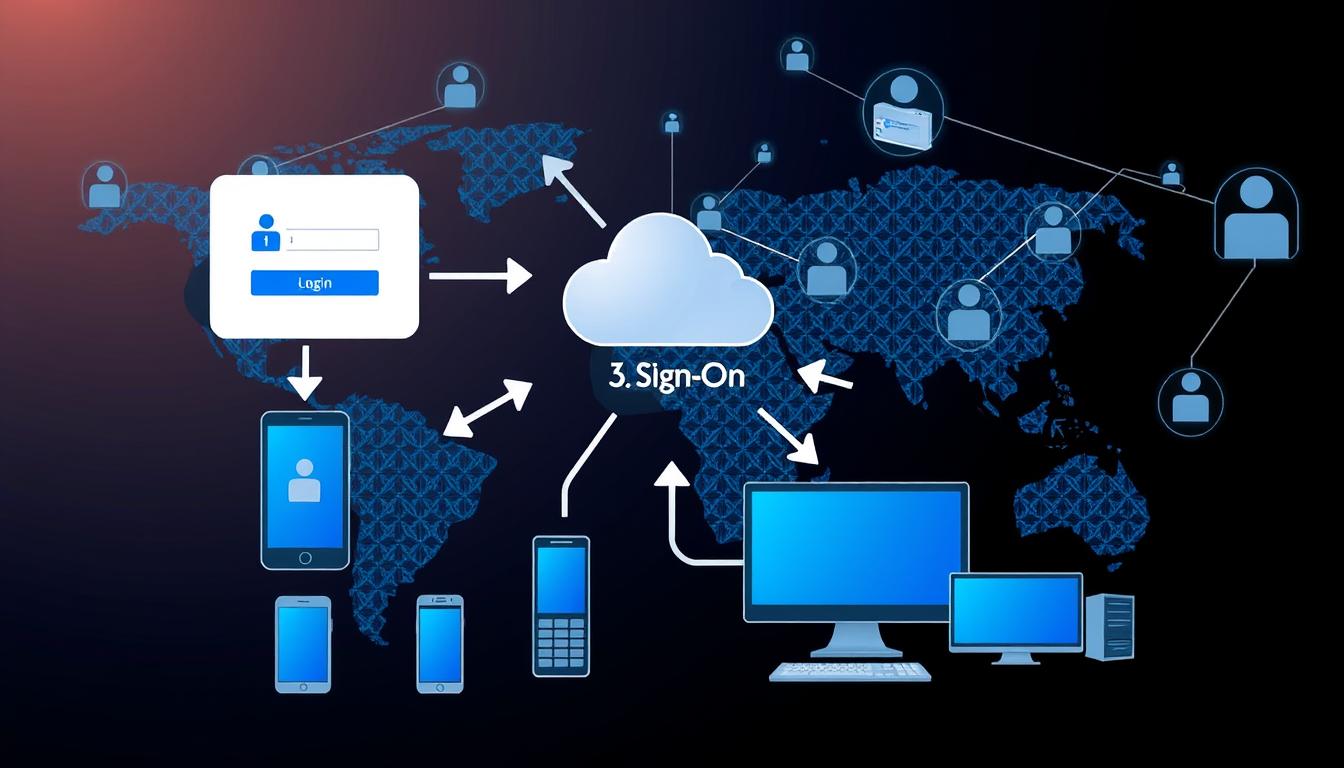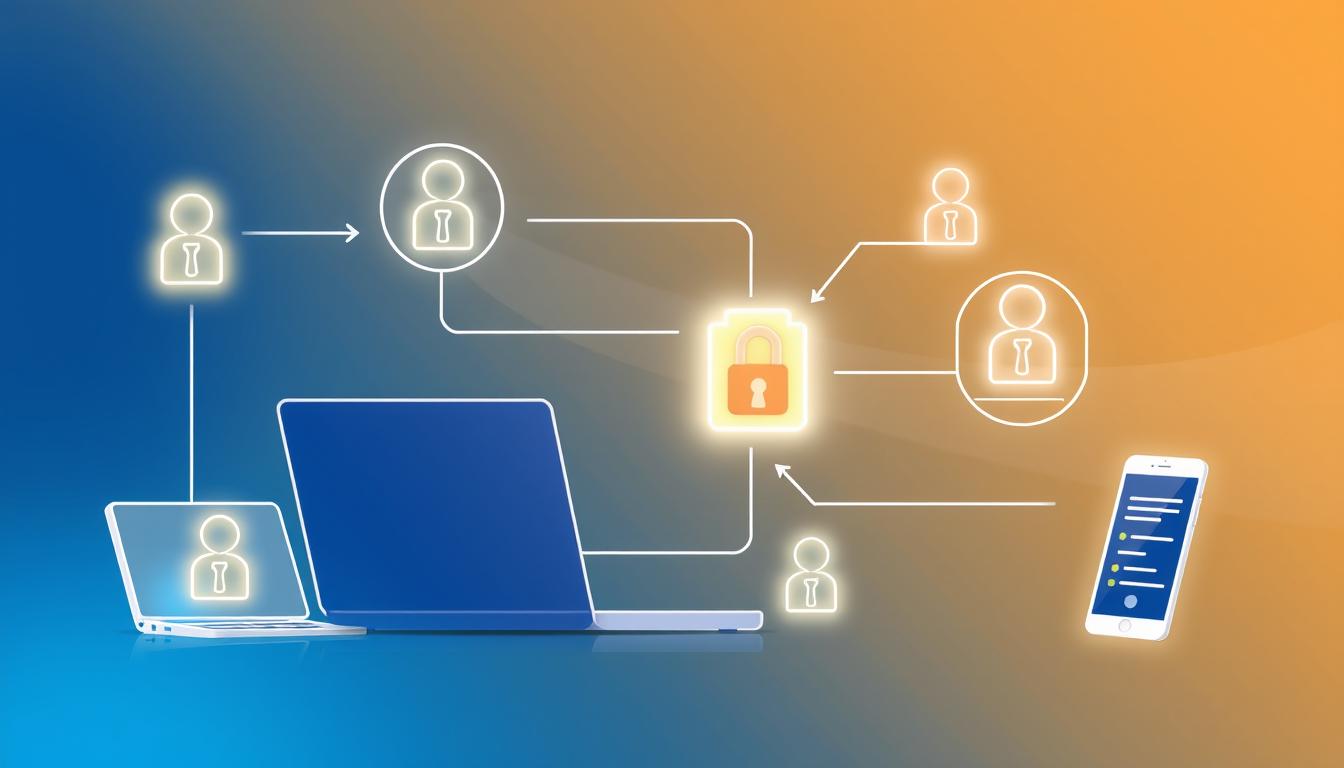
Digital authentication has changed a lot with Single Sign-On (SSO) technology. As 84% of users get tired of passwords, SSO is key for easier access to many digital platforms. It lets users log into many apps with just one set of credentials, making it simpler to get started.
SSO is a smart way to handle login details in today’s digital world. It lets users log in once and access many systems. This makes remembering lots of passwords easier and boosts security.
More companies are using SSO, with a 40% adoption rate expected by 2025. It makes things easier for users and adds strong security to protect against unauthorized access and data breaches.
Key Takeaways
- SSO eliminates multiple login requirements across different platforms
- Reduces password-related security vulnerabilities
- Streamlines user authentication processes
- Decreases help desk support for password reset requests
- Supports enterprise security management
- Improves overall user experience and productivity
What is Single Sign-On SSO
Single Sign-On (SSO) is a smart way to log into many digital sites with just one set of login details. It makes it easier for users to get into different software systems without hassle.

SSO brings big advantages to both companies and users. It mainly helps by making login processes smoother and boosting digital security.
Core Definition and Basic Concepts
At its heart, SSO is about managing identities across many apps. It works on a few main ideas:
- One login for many systems
- A single place for all logins
- Less hassle with passwords
- Better experience for users
The Evolution of SSO Technology
SSO tech has changed a lot over time. What started as simple and complex has grown into something strong and safe for many platforms.
“SSO enables users to access multiple applications with a single authentication event, revolutionizing digital identity management.”
Key Components of SSO Systems
SSO’s success comes from its key parts:
- Identity Providers (IdP)
- Service Providers (SP)
- Authentication Protocols
- Token Management Systems
These parts work together to make a secure and easy login system. It cuts down on password problems while keeping security high.
How Single Sign-On Authentication Works
Single Sign-On (SSO) authentication changes how we log into many digital platforms with just one set of credentials. It makes logging in easier and keeps more applications and services secure.

- Identity Provider (IdP)
- Service Provider (SP)
- User Authentication Server
Here’s what happens when you try to log into an app:
- User initiates login request
- Identity verification through central authentication server
- Token generation for secure access
- Automatic authentication across connected platforms
“SSO reduces password fatigue while maintaining robust security protocols” – Cybersecurity Expert
Today’s Single Sign-On solutions use advanced tech like SAML 2.0 and OAuth. These tools make logging in fast and safe. They help big companies manage their digital spaces better.
The process uses special tokens to check who you are without asking for your password again. This makes it safer and easier for users.
Businesses really gain from SSO, cutting down on IT help desk calls by 20-50%. With Single Sign-On, companies can manage access better and save time and money.
The Architecture of SSO Systems
Single Sign-On (SSO) is a smart way to log in to many sites with just one password. It makes logging in easier and safer. This is thanks to its strong security features.
At the heart of SSO is a simple login process. It cuts down on password problems and boosts security. This makes digital systems work better and feel more user-friendly.
Authentication Flow Process
The login process in SSO systems is key:
- User tries to get into a protected app
- Identity provider gets the login request
- User’s login details are checked
- A secure token is made
- The user gets into the app they wanted
Token-Based Authentication Mechanisms
Token-based authentication is the core of SSO. These digital tokens:
- Give safe, short-term login details
- Stop the need for logging in over and over
- Let users log in to different apps easily
“Tokens represent the digital passport in our interconnected application landscape.” – Security Authentication Expert
Identity Provider Integration
Good SSO needs strong identity provider links. Today’s companies use SAML and OAuth to link apps and systems safely.
With smart SSO, companies can lower security risks. Studies show a 30% drop in possible login breaches.
Types of SSO Implementations
Single Sign-On (SSO) solutions have grown to meet various security needs. They work in different tech settings. Companies can pick from many SSO types based on their needs and setup.
- SAML (Security Assertion Markup Language) SSO: Mainly used in big companies for safe login between different systems
- Kerberos-based SSO: Common in Windows networks for strong login checks
- OAuth/OpenID Connect Solutions: Great for web and mobile apps for easy login
Each SSO type has its own benefits:
| Implementation Type | Primary Use Case | Key Benefit |
| CAS (Central Authentication Service) | Higher Education | Boosts server-to-server talks |
| Shibboleth | Federated Institutional Access | Makes sharing apps safe |
| Enrollment-Based SSO | Browser Sessions | Keeps login info safe |
“SSO solutions cut down on password help desk calls by making login easier.” – Cybersecurity Expert
Companies using Single Sign-On see big security wins. They have fewer login spots and smoother login steps. This makes it harder for hackers and better for users.
Choosing the right SSO depends on what the company needs, its setup, and security rules. It’s key to look at things like how well it scales, how easy it is to connect with other systems, and if it meets standards.
Enterprise SSO vs Social SSO Solutions

Today, companies face big challenges with how people log in. The world of Single Sign-On (SSO) has changed a lot. Now, there are many ways to make logging in easier and safer for everyone.
Enterprise SSO Implementation Strategies
Enterprise SSO solutions are strong for big companies. They use:
- Centralized identity management
- Integration with existing security systems
- Comprehensive access control
About 86% of companies using Enterprise SSO saw better work from their employees. It usually takes 3-6 months to set up, depending on how big and complex the company is.
Social Media SSO Integration
Social SSO makes logging in easier. 80% of companies saw big improvements in how they welcome new customers with social login options.
“Social SSO reduces friction in user authentication, creating seamless digital experiences.” – Identity Management Expert
Choosing Between SSO Types
Choosing the right SSO solution is important. Look at these key things:
- How secure you need it to be
- How easy it is for users
- What apps you use
- Any rules you have to follow
Companies need to find a balance between being safe and easy to use. With 90% of users liking Google and Facebook for logging in, social SSO is a popular choice.
SSO strategies keep getting better. They solve big login problems while keeping everything safe and secure.
Security Benefits of Single Sign-On

Single Sign-On (SSO) brings big security wins for companies in today’s digital world. It makes logging in easier and safer, cutting down on password problems.
The benefits of SSO are many and important:
- Reduces password-related vulnerabilities
- Minimizes possible attack surfaces
- Boosts overall cybersecurity for the company
SSO makes a big difference in security. 59% of users reuse passwords across multiple accounts, which is a big risk. SSO stops this by letting users log in once a day with one set of credentials.
“SSO can lead to a 75% reduction in login-related help desk calls, fundamentally transforming organizational security infrastructure.”
SSO makes following rules easier too. Rules like Sarbanes-Oxley and HIPAA need strong user checks, which SSO does well. Companies can keep their security tight while following rules better.
SSO does more than just keep things safe. It saves IT teams time on password stuff. Big companies using SSO say they get a lot done faster, saving up to 30 minutes on each request.
As threats grow, SSO is a key part of keeping safe online.
Potential SSO Security Risks and Mitigation
Single Sign-On (SSO) solutions make life easier, but they also bring big security challenges. It’s key to know the risks to keep SSO systems safe.
Cybersecurity experts say SSO systems are tempting targets for hackers. If one set of login details is stolen, hackers can get into many apps and sensitive areas.
Common Security Vulnerabilities
The biggest SSO security risks are:
- Token hijacking vulnerabilities
- Weak authentication mechanisms
- Insufficient session management
- Insecure communication channels
“A breach in SSO can expose an entire organizational ecosystem to possible cyber threats.” – Cybersecurity Research Institute
Risk Management Strategies
To keep SSO systems safe, you need to take these steps:
- Implement multi-factor authentication
- Deploy continuous monitoring systems
- Do regular security checks
- Encrypt sensitive login data
Best Security Practices
To make Single Sign-On better, follow these important steps:
- Enable strong password policies
- Integrate real-time threat detection
- Limit session times
- Use secure token management protocols
By taking proactive steps, you can cut down on the risk of stolen login details by up to 99.9%. The trick is to find a balance between making things easy for users and keeping them safe.
SSO Implementation Best Practices
Setting up Single Sign-On (SSO) solutions needs a careful plan. It must balance security, user experience, and work efficiency. Companies starting SSO must think about many important things to make it work well.
Some top tips for SSO setup include:
- Do a full check of how you handle logins now
- Pick strong SSO tech with good security records
- Add extra login checks for better safety
- Make plans for teaching users how to use it
- Use access rules based on roles
Experts say to start SSO slowly. First, map out your current login systems, find where to connect, and set up security rules. Using one place for all identities can really cut down on security problems.
“SSO implementation is not just a technological upgrade, but a strategic transformation of organizational access management.” – Cybersecurity Leadership Forum
Numbers show why SSO is key. Research shows that SSO can:
- Halve the number of calls to the help desk for password resets
- Lower risks of unauthorized access by 99.9% with extra login checks
- Boost user work speed by about 25%
- Make your security stronger by fixing weak spots in login info
Keeping an eye on things, doing security checks often, and updating how you check logins is vital. By sticking to these tips, companies can build a safe, easy-to-use system for logging in.
SSO Standards and Protocols
Single Sign-On (SSO) uses advanced protocols for safe and easy access to many platforms. Knowing these standards is key for companies to manage identities well.

Today’s SSO uses several important protocols. These ensure users can log in securely and efficiently to various systems and apps.
SAML Protocol Fundamentals
Security Assertion Markup Language (SAML) is a vital XML standard for sharing authentication data. It helps with federated identity management by linking identity providers with service providers.
- XML-based security token exchange
- Supports enterprise-wide single sign-on
- Facilitates cross-domain authentication
OAuth and OpenID Connect
OAuth 2.0 and OpenID Connect are key authorization frameworks for SSO. They make it safe for users to share access without giving out their passwords.
| Protocol | Primary Function | Key Characteristic |
| OAuth 2.0 | Authorization | Third-party access control |
| OpenID Connect | Authentication | JSON Web Token based |
Kerberos Authentication
Kerberos is a strong authentication protocol used in many companies. It uses tickets for secure login, making sure data is encrypted when sent between users and servers.
“Kerberos represents a gold standard in network authentication protocols.” – Security Expert
Understanding these SSO standards and protocols helps companies set up better, safer, and easier login systems.
Business Benefits and ROI of SSO
Single Sign-On (SSO) offers big benefits beyond just logging in easily. It helps companies work better and save money. This makes their digital setup much stronger.

SSO brings many good things. It makes work faster, safer, and cheaper. It also makes logging in easier for everyone.
Key Business Advantages of SSO
- Reduce IT support costs by minimizing password-related helpdesk calls
- Enhance employee productivity through simplified access management
- Improve security posture with centralized authentication
- Decrease password reset time and user frustration
Looking at numbers shows how good SSO is. It cuts down on 50% of helpdesk calls about passwords.
“SSO transforms authentication from a complex challenge to a streamlined, secure process.” – Cybersecurity Expert
Financial Impact of SSO Implementation
| Metric | Potential Improvement |
| IT Support Costs | Reduced by 30-40% |
| User Productivity | 5-15 seconds saved per login |
| Software Adoption Rates | Increased by 25% |
SSO with strong security like Multi-Factor Authentication boosts both user happiness and safety. It grows with your business, keeping things smooth.
Common SSO Implementation Challenges
Single Sign-On (SSO) makes logging in easier for companies. But, it’s not without its hurdles. Companies face big challenges when they try to use SSO with different technologies.
Some of the main problems include:
- Getting SSO to work with old systems
- Connecting different ways to log in
- Handling many different apps and systems
- Keeping the login system up and running
Trying to set up SSO can be very technical. More than 75% of companies struggle with making SSO work. Each company uses its own way to manage who can log in, from big platforms to their own systems.
“SSO implementation is not just a technical challenge, but an organizational transformation process.”
Security is also a big worry. About 30% of companies have had problems with SSO because of security issues. The SAML language, used for SSO, can be tricky and lead to security problems if not done right.
There are also costs to consider. Setting up SSO can take a lot of time, which can hurt a company’s plans. But, companies that do it well can save a lot on helpdesk costs, up to 80%.
To tackle SSO challenges, companies need a solid plan. They must do thorough security checks and keep working on it to avoid problems and make the system work better.
Future Trends in SSO Technology
The world of Single Sign-On (SSO) technology is changing fast. New technologies and better security needs are driving these changes. As digital worlds get more complex, SSO is evolving to tackle today’s authentication and access challenges.
Emerging Technologies Reshaping SSO
Big changes are happening in SSO technology. Here are some key trends:
- Passwordless authentication solutions gaining momentum
- AI-powered threat detection becoming standard
- Increased integration with cloud-based platforms
- Advanced biometric authentication methods
Zero Trust Integration
SSO is now merging with Zero Trust security. This is a big step in access management. It’s not just about logging in anymore. It’s about creating smart, changing access controls based on who you are and where you are.
“The future of SSO lies in intelligent, adaptive authentication that verifies user identity continuously.” – Cybersecurity Expert
| Technology Trend | Projected Growth | Key Impact |
| Passwordless Authentication | 50% adoption by 2025 | Reduced credential compromise |
| AI-Enhanced Threat Detection | 50% improvement | Enhanced security capabilities |
| Zero Trust SSO Models | 45% growth in 3 years | Comprehensive access control |
The access management market is expected to grow from $8 billion in 2020 to over $20 billion by 2026. This shows how important new SSO technologies are for keeping our digital world safe.
Conclusion
Single Sign-On (SSO) is key for today’s businesses. It balances security with ease for users. SSO cuts down on password risks and makes accessing apps simpler.
About 65% of companies use or plan to use SSO. It’s a must-have for strong cybersecurity.
SSO does more than just log you in. It boosts productivity by up to 30% and cuts helpdesk calls by 50%. It makes security better and user experience smoother.
SSO will keep growing with new tech and security needs. Managing access securely is vital in today’s digital world. Companies need to pick SSO that’s secure, easy to use, and flexible.
SSO is more than tech; it’s a way to handle digital identities. It helps businesses stay safe and user-friendly online.